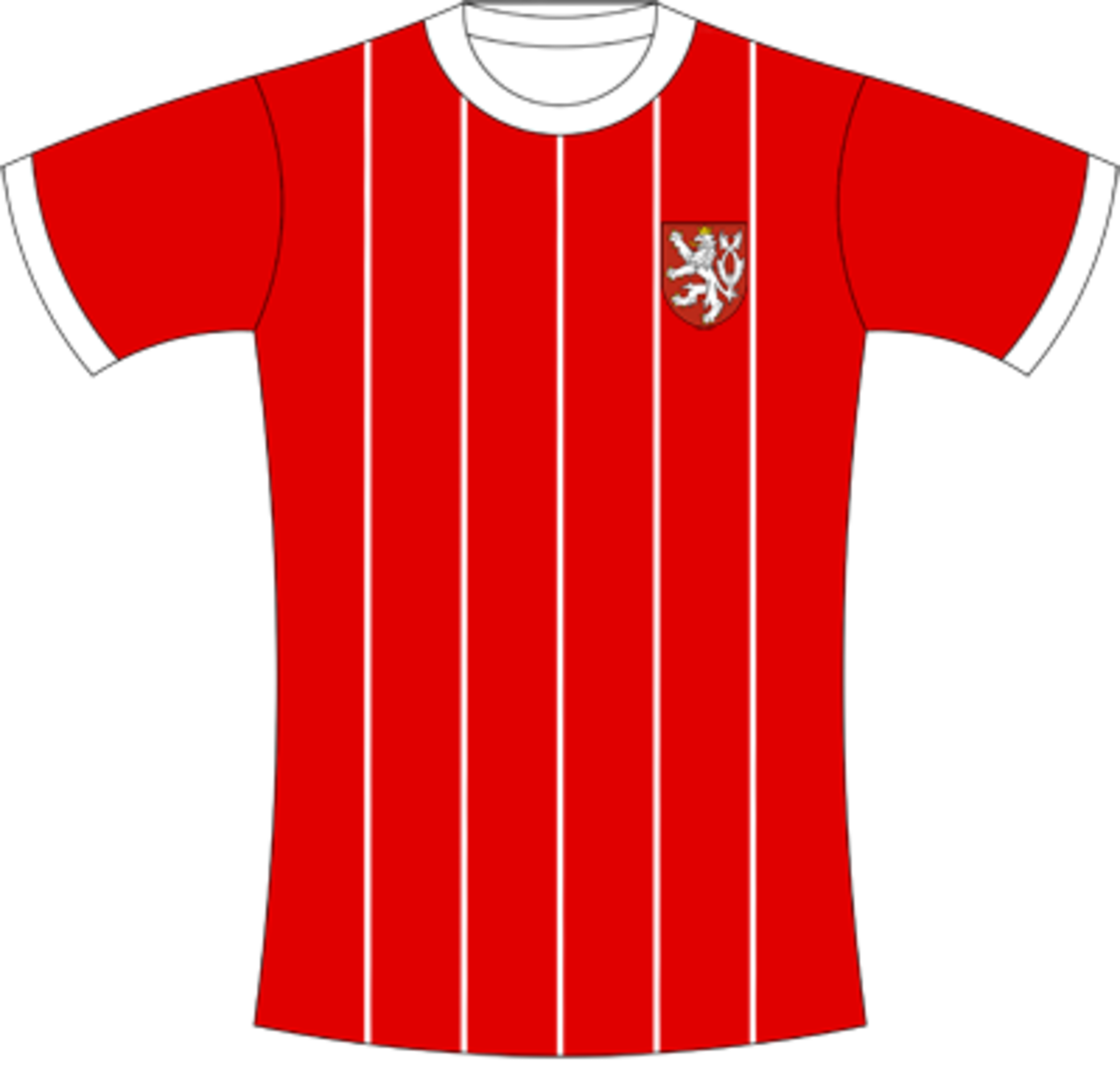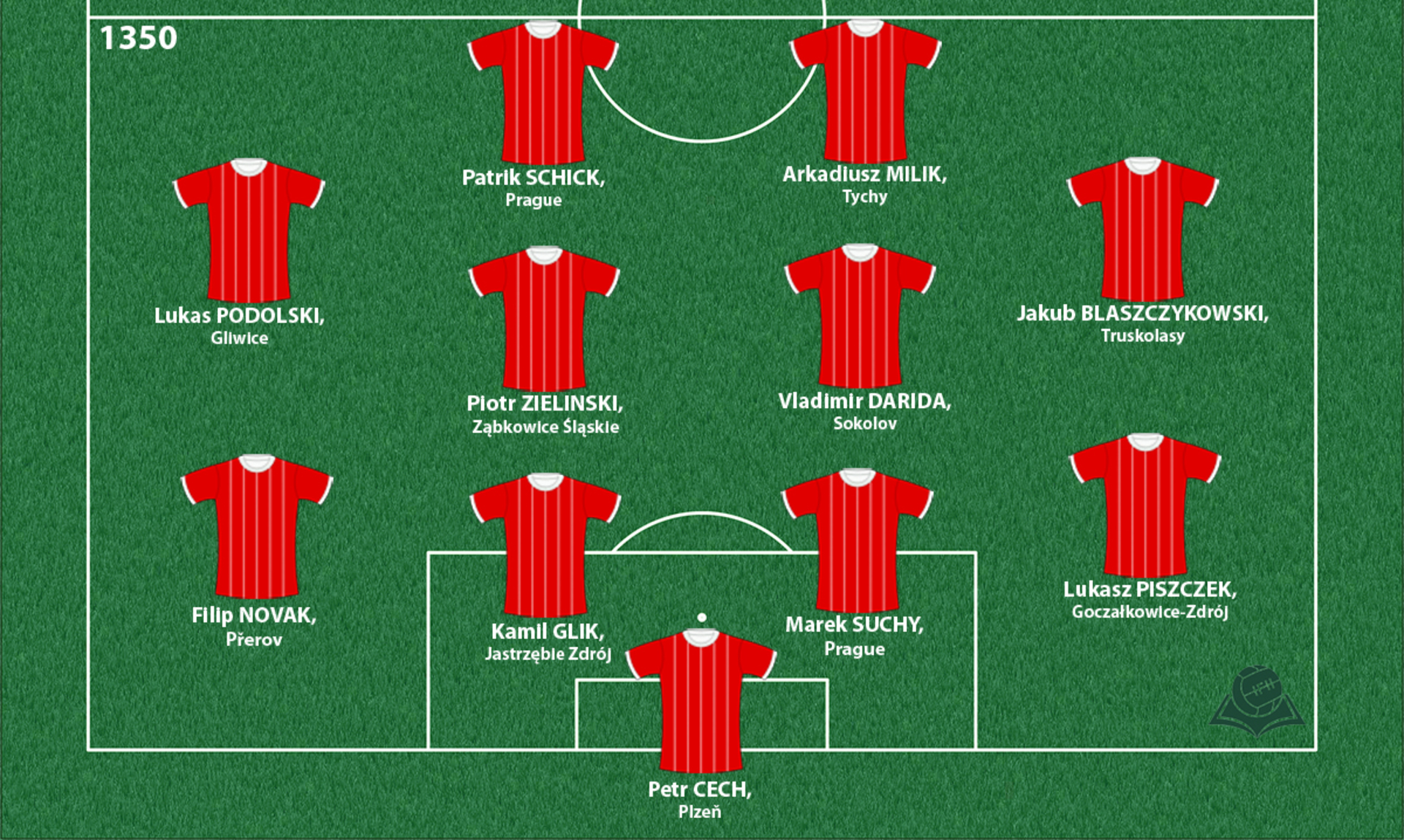Lands of the Bohemian Crown
In the mid of the 14th century the Lands of the Bohemian Crown was consisted from Kingdom of Bohemia (or Czech Kingdom), Margraviate of Moravia, the Duchies of Silesia and the Lusatias under the Bohemian kings Within The Holy Roman Empire.. It was neither a personal union nor a federation of equal members. Rather, the Kingdom of Bohemia had a higher status than the other incorporated constituent countries.

Coat of arms

Shirt
| Position | First name | Last name | Mjesto rođenja | Like | Dislike | |
|---|---|---|---|---|---|---|
| GK | Lukasz | SKORUPSKI | Zabrze |
1 |
2 |
|
| GK | Petr | CECH | Plzeň |
10 |
0 |
|
| GK | Tomas | VACLIK | Ostrava |
0 |
2 |
|
| DC | Jakub | BRABEC | Prague |
0 |
1 |
|
| DC | Jaroslaw | JACH | Bielawa |
0 |
0 |
|
| DC | Kamil | GLIK | Jastrzębie Zdrój |
11 |
0 |
|
| DC | Marek | SUCHY | Prague |
0 |
1 |
|
| DC | Tomas | SIVOK | Pelhřimov |
1 |
1 |
|
| DLC | Michal | KADLEC | Vyškov |
1 |
2 |
|
| DRLC | Tomas | KALAŠ | Olomouc |
5 |
1 |
|
| DRL | Theodor | GEBRE SELASSIE | Třebíč |
7 |
1 |
|
| DR | Lukasz | PISZCZEK | Goczałkowice-Zdrój |
14 |
3 |
|
| DR/MR | Pavel | KADERABEK | Prague |
1 |
0 |
|
| DLC/ML | Filip | NOVAK | Přerov |
1 |
2 |
|
| DMC | Piotr | ZIELINSKI | Ząbkowice Śląskie |
10 |
2 |
|
| DMC | Vladimir | DARIDA | Sokolov |
1 |
0 |
|
| DMC/DL | Eugen | POLANSKI | Sosnowiec |
0 |
1 |
|
| MC | David | PAVELKA | Prague |
0 |
0 |
|
| MC | Jakub | JANKTO | Prague |
1 |
0 |
|
| MC | Josef | HUSBAUER | Prague |
0 |
0 |
|
| AMC | Antonin | BARAK | Pribram |
0 |
0 |
|
| AMC | Borek | DOCKAL | Městec Králové |
1 |
0 |
|
| AMRLC | Ladislav | KREJCI | Prague |
1 |
0 |
|
| MRL | Jaromir | ZMRHAL | Žatec |
1 |
0 |
|
| AMRL | Jakub | BLASZCZYKOWSKI | Truskolasy |
3 |
0 |
|
| AMRL | Jan | KOPIC | Jihlava |
0 |
0 |
|
| SS/FC | Lukas | PODOLSKI | Gliwice |
12 |
1 |
|
| FRLC | Arkadiusz | MILIK | Tychy |
15 |
3 |
|
| FRLC | Matej | VYDRA | Chotěboř |
0 |
1 |
|
| FRLC | Michael | KRMENCIK | Kraslice |
0 |
0 |
|
| FRLC | Vaclav | ČERNY | Příbram |
0 |
0 |
|
| FC | Patrik | SCHICK | Prague |
6 |
4 |
|
| FC | Tomas | NECID | Pelhrimov |
0 |
1 |
(Today part of: Czech Republic and Silesia in Poland)
The Christianization of the Hungarian and Polish ruling elites at the beginning of the 11th century had stopped the Czech incursions towards the east and north, and bound the Bohemian state even more firmly to the Holy Roman Empire, whose part it then became. Seen as how it was a kingdom within the Empire, the emperors would often meddle in its internal politics, which was met with resistance by its rulers and nobility. However, the Bohemian state already had very firm connections with German lands which were impossible to sever, and Bohemian kings had higher prestige as princes of the Holy Roman Empire with the right to choose the emperor.
The example of the Bohemian king from the Luxembourg dynasty Charles IV (ruled 1346–1378) shows that the Bohemian state managed to draw great benefits for itself from its membership in the Empire. He became the emperor of the Holy Roman Empire in mid-14th century and made Prague an important political and, after the foundation of the University in 1348, an important cultural center of Europe in those days. Charles is also responsible for the so-called Lands of the Crown of St. Wenceslas or Lands of the Bohemian Crown (Corona regni Bohemiae), staying mutually connected regardless of the dynastic changes. The Bohemian state, in this case, represented the “head,” while the other lands were merely the “limbs.” Also, because of the University of Prague, a critical attitude towards the Catholic Church and its gaining of wealth will develop in Bohemia at the beginning of the 15th century, and consequently a reformation movement rose under the leadership of Jan Hus, with the goal of “fixing” Christianity, while strictly adhering to God’s Law from the Bible.
Sources
- Povijest Češke: Od seobe Slavena do suvremenog doba, Milan Šarac (ur.), Zagreb: Sandorf, 2014.
- ''Kako su potomci fanatičnih ratnika postali vjerski ravnodušni realisti'', http://www.tportal.hr/kultura/knjizevnost/345862/Kako-su-potomci-fanaticnih-ratnika-postali-vjerski-ravnodusni-realisti.html
- ''Zemlje Krune sv. Vaclava'', https://hr.wikipedia.org/wiki/Zemlje_Krune_sv._Vaclava
